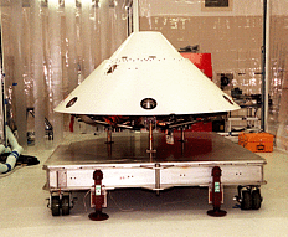The Mars Polar Lander during tests.
Click on image for full size
Courtesy of NASA
Mars Lander may be Alive
News story originally written on January 27, 2000
Just when everyone had given up hope, a faint signal was received at Stanford University. Scientists say it most likely came from Mars, although they won't know for sure until later this week. The signals came on December 18, and January 4, which are the two days the lander was told to send a signal to Earth.
"The circumstantial evidence indicates that the signals came from Mars, and if that is the case there is a good chance they came from the Lander," project manager Richard Cooke said. "The signals that were received were like a whisper among a lot of static."
Scientists say it is very unlikely that the Polar Lander could continue the mission, even if it is still alive. They are hoping the craft could at least give them some information about its landing. Investigators are trying to find out what caused the disaster.
The concept of a living lander puzzled and surprised the entire Mars Polar Lander team. "I was blown away," said flight operations manager Sam W. Thurman. "Imagine coming back from the funeral of a dear friend and getting a phone call saying ... he's not dead after all."
You might also be interested in:

Amongst reports that the Mars Polar Lander fell into a deep canyon, scientists are reporting the cause of the disaster is still unknown.Organizers of the mission also pointed out they knew the canyon
...more
It was another exciting and frustrating year for the space science program. It seemed that every step forward led to one backwards. Either way, NASA led the way to a great century of discovery. Unfortunately,
...more
The Space Shuttle Discovery lifted off from Kennedy Space Center at 2:19 p.m. EST, October 29th. The sky was clear and the weather was great as Discovery took 8 1/2 minutes to reach orbit for the Unitied
...more
A moon was discovered orbiting the asteroid, Eugenia. This is only the second time in history that a satellite has been seen circling an asteroid. A special mirror allowed scientists to find the moon
...more
Will Russia ever put the service module for the International Space Station in space? NASA officials are demanding an answer from the Russian government. The necessary service module is currently waiting
...more
During a period of about two days in early May, 1998, the ACE spacecraft was immersed in plasma associated with a coronal mass ejection (CME). The SWICS instrument on ACE, which determines unambiguously
...more
J.S. Maini of the Canadian Forest Service has referred to forests as the "heart and lungs of the world." Forests reduce soil erosion, maintain water quality, contribute to atmospheric humidity and cloud
...more














